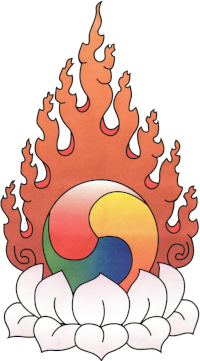Briefly speaking to practice Buddhism there are three things: learning, thinking – or contemplating – and meditating. Learning doesn’t mean to become a great scholar or teacher. At least, you have to know what you are doing. I just want to bring this up to date. One shouldn’t do what one doesn’t know. That’s very important for every spiritual path. It is an unknown road and you should not do something that you don’t know how to do. At least you need to know what it is.
Yes, it is Buddha’s teaching and the great Tibetan Buddhist tradition. But what is the individual supposed to learn and think and meditate? These are the questions. Otherwise you simply go and “meditate.” Meditation is now somehow accepted as one of the alternative methods for gaining health and happiness, something like yoga. But that meditation probably means just sitting down and focusing and trying not to engage any thoughts, just bringing attention to every movement. You all know this. Many people know that. That’s good and there is nothing wrong with that. I need to say this. But as a Tibetan Buddhist student and spiritual person I have to say: that’s not enough. It’s good to bring some calm and quiet to people and reduce your blood pressure and give you a little relaxation. It’s great for that, no doubt about it. But to make the spiritual journey perfect it is not good enough.
That’s why learning becomes important. You have to learn about the subject or object that you are going to meditate on. If you don’t learn anything but simply sit down and watch your breath at your abdominal movement, or counting the breath going up and down, or in and out the left, or right nostrils, or both together, that’s very limited focusing. Some people have a little better object to focus on, like an image of Buddha or Tara or something. That’s a little better than counting the breath. It’s better in the sense that you learn to keep your attention on a certain subject or object, plus you accumulate positive merit, because you are focusing on Buddha or other enlightened beings. That will bring positive karma. It is also an opportunity to reduce negativities. Focusing on an image of the Buddha or Tara is a preferred object to meditate compared to counting the breath.
But you do have to count your breath in order to learn how to focus. I have an interesting story. A long time ago I had a friend in Texas, a healer. He told me about “meditation.” At that time my language problem as well as the lack of clarity of what he meant by meditation prompted me to say, “I don’t know what that is.” Then he said, “I will teach you.” I said, “That will be very fine.” So he lit a 4 – 5 inch long stick of incense. In the air-controlled room the smoke want up straight. He kept on telling me: “Keep on focusing on the smoke at the point where the fire is burning the incense until the incense has burnt down.” Then I began to realize what kind of meditation he was talking about. It was focusing. So focusing on the image of the Buddha or Tara, etc, is better than focusing on incense smoke or counting your breaths. Counting breaths helps because it connects with your physical movements. The body-mind relationship is very strong. The physical movements here draw the attention of the mind. That’s why counting breaths becomes important. But that’s not good enough for spiritual practitioners.
~ Gelek Rimpoche, Jewel Heart Ann Arbor, April 8, 2012


